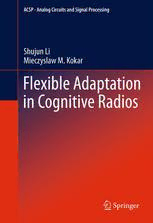
Flexible Adaptation in Cognitive Radios PDF
Preview Flexible Adaptation in Cognitive Radios
Flexible Adaptation in Cognitive Radios ANALOGCIRCUITSANDSIGNALPROCESSING SeriesEditors: MohammedIsmail.The OhioStateUniversity MohamadSawan.E´colePolytechniquedeMontre´al Forfurthervolumes: http://www.springer.com/series/7381 Shujun Li (cid:129) Mieczyslaw M. Kokar Flexible Adaptation in Cognitive Radios 123 ShujunLi MieczyslawM.Kokar NortheasternUniversity NortheasternUniversity Boston Boston USA USA ISBN978-1-4614-0967-0 ISBN978-1-4614-0968-7(eBook) DOI10.1007/978-1-4614-0968-7 SpringerNewYorkHeidelbergDordrechtLondon LibraryofCongressControlNumber:2012948345 ©SpringerScience+BusinessMedia,LLC2013 Thisworkissubjecttocopyright.AllrightsarereservedbythePublisher,whetherthewholeorpartof thematerialisconcerned,specificallytherightsoftranslation,reprinting,reuseofillustrations,recitation, broadcasting,reproductiononmicrofilmsorinanyotherphysicalway,andtransmissionorinformation storageandretrieval,electronicadaptation,computersoftware,orbysimilarordissimilarmethodology nowknownorhereafterdeveloped.Exemptedfromthislegalreservationarebriefexcerptsinconnection with reviews or scholarly analysis or material supplied specifically for the purpose of being entered and executed on a computer system, for exclusive use by the purchaser of the work. Duplication of this publication or parts thereof is permitted only under the provisions of the Copyright Law of the Publisher’slocation,initscurrentversion,andpermissionforusemustalwaysbeobtainedfromSpringer. PermissionsforusemaybeobtainedthroughRightsLinkattheCopyrightClearanceCenter.Violations areliabletoprosecutionundertherespectiveCopyrightLaw. Theuseofgeneraldescriptivenames,registerednames,trademarks,servicemarks,etc.inthispublication doesnotimply,evenintheabsenceofaspecificstatement,thatsuchnamesareexemptfromtherelevant protectivelawsandregulationsandthereforefreeforgeneraluse. While the advice and information in this book are believed to be true and accurate at the date of publication,neithertheauthorsnortheeditorsnorthepublishercanacceptanylegalresponsibilityfor anyerrorsoromissionsthatmaybemade.Thepublishermakesnowarranty,expressorimplied,with respecttothematerialcontainedherein. Printedonacid-freepaper SpringerispartofSpringerScience+BusinessMedia(www.springer.com) To Mom,Dad, Xu,andWinston Preface The concept of cognitive radio, first introduced by Mitola in 2000, envisioned it as a cognitive agent capable of autonomous operation in pursuing its own goals,communicationwithotheragents,flexibleadaptation,reasoningandlearning. However,nowadaystheterm“cognitiveradio”istypicallyinterpretedasaradiothat isabletomonitortheunusedspectruminitsenvironmentandselectingspectrumfor owntransmissionswithoutinterferingwiththelicensedusersofthegivenspectrum band. Thisbooktakesuponthechallengesofrealizingtheoriginalgoalsofcognitive radio. Although it focuses on the topic of flexible link adaptation, the various technical solutions presented in this book will be useful for realizing the rest of thegoalsoftheoriginalvisionforcognitiveradio. While adaptation is incorporated in essentially all communications protocols, suchadaptationsare limitedto the situationsenvisionedby the protocolandradio designers.Protocol-basedsolutionscannotdealwiththeunknown.Inotherwords, such adaptationslackthe flexibilityin the typesof feedbackthey can process,the typesofresponsestothefeedbacktheycaninvokeandmostimportantlytheycannot negotiatebettersolutionswithotherradiosornetworknodes. A greater flexibility of adaptation could be achieved via two mechanisms— collaborativenegotiationofsolutionsandlearning.Inthisbookwearefocusingon thefirst ofthe approaches.Incommunications,like in dancing,it takestwoto the tango.Oneradiocannotmodifythecommunicationsprotocolwithoutagreeingon suchachangewithitspeers.Neithercanitdictatewhatthepeerneedstodowithout consideringthecapabilitiesoftheotherradio.Radiosneedtonegotiatechangesin the protocol. The question is—what language can they use for such negotiations. Thisbookdescribessuchalanguageandmechanismstoachievecollaboration.The potentialusabilityandpowerofsuchalanguageshouldnotbeunderestimated. Boston,MA ShujunLiandMieczyslawM.Kokar vii Acknowledgement Five years ago, back in September 2007, I started my Ph.D program with little clue of which research direction I am headingfor and what my life will be in the followingfewyears.Oneday,a friendin ourdepartmenttoldmethatProf.Kokar islookingforaResearchAssistant.Afterbrowsinghispersonalwebsite,Idecided togiveitatry.EverythingwentverysmoothlyandtwoweekslaterIbecameProf. Kokar’s student. I didn’t realize that how lucky I am to make such a decision, a decisionthatwillpavethewayfora 4-yearadventurefullofjoyfulchallengeand fruitfulharvest. This book is a memento of the great days in these 4 years. I would like to express my deepest gratitude to Prof. Mieczyslaw M. Kokar, my Ph.D advisor. His passion, perseverance and patience always inspired me with new ideas and encouraged me not to give up in the difficult times. His humor always spiced up the lengthy discussions we had in his office and also made him a good company duringourtrips to numerousacademicconferencesthroughoutthe years. Without his constant guidance, advice and support, this book would not exist. I am also enormouslygratefultomycolleagueDr.JakubMoskalforbeingsuchawarmand supportivefriendandforhishelpontheimplementationoftheusecase.Iowebig thankstothoseintheWirelessInnovationForumandIEEEP1900.5WorkingGroup whoinspiredmewithnewideasandgavedetailedcommentsonmyworkthrough theface-to-facemeetings,teleconferencesandemaildiscussions. I would like to thank my editor Dr. Mohammed Ismail. He attended my presentation at the SDR’10 conference and encouraged me to publish my thesis into this book.I also want to thank my editorsCharles Glaser and AugustineLeo fortheirpatienceandhelpfulnessthroughthebookproductionprocess. I give my special thanksto my parents, Yujuan Xuan and Jianping Li, and my uncle Wenzhan Xuan, for their unconditional love and support in the past thirty years. ix x Acknowledgement Todaymarksthe11thanniversaryofmyhusbandXuNingandIbeingtogether. No word can express how grateful I am to have him in my life. Throughout the years,hislove,tolerance,passionfortechnologyandcuriosityabouttheworldhas always fueled me to achieve my fullest potential and pursue those unimaginable dreams.Finally, I wantto dedicatethis bookas the first giftto our babyWinston, whoisexpectedtofinallymeetusinafewweeks.
